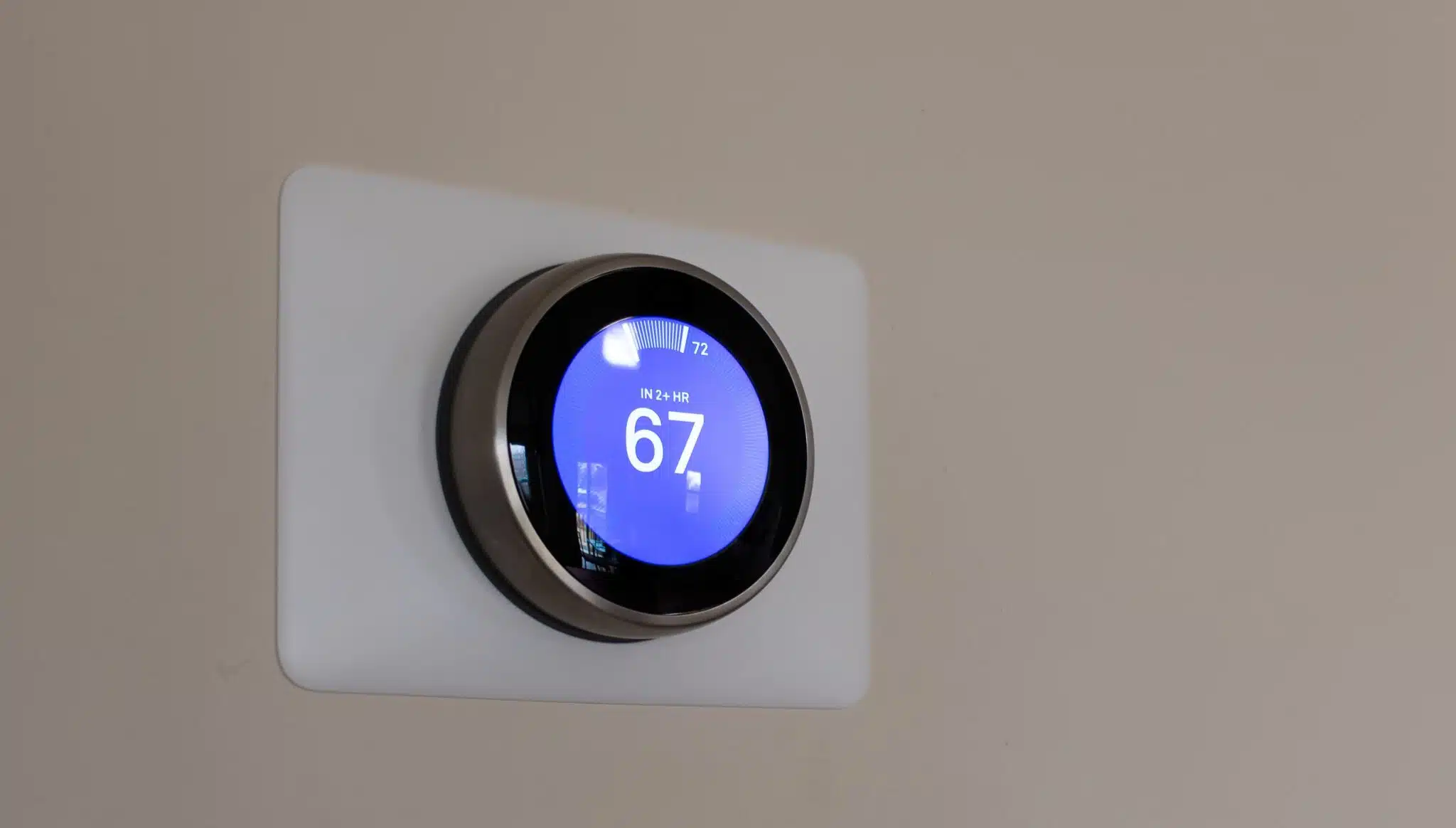Choosing the best thermostats for your home in Lancaster, PA, is about more than just adjusting the temperature. With February bringing unpredictable winter weather, the right thermostat can improve comfort and energy efficiency while reducing strain on your heating system. Whether you are considering a smart upgrade or prefer a traditional option, understanding key features and compatibility is essential. This guide explores the latest thermostat technology, energy-saving benefits, and important factors to keep in mind when selecting the right thermostat for your home.
Understanding Thermostat Types for Lancaster’s Winter Climate
Selecting the best thermostats for your home depends on your heating system, energy efficiency needs, and daily routine. The three main types—manual, programmable, and smart thermostats—offer varying levels of control and convenience.
Manual thermostats provide basic temperature adjustments without automation. While simple and budget-friendly, they require frequent changes to maintain consistent comfort, making them less efficient for Lancaster’s fluctuating February weather.
Programmable thermostats allow users to set heating schedules in advance. This feature helps regulate indoor temperatures automatically, reducing energy waste while ensuring a warm and comfortable home during unpredictable winter days.
Smart thermostats take efficiency further by learning your routine and adjusting settings accordingly. Equipped with Wi-Fi connectivity and remote access, they provide precise climate control and real-time energy monitoring for maximum savings.
The best thermostats balance convenience, efficiency, and system compatibility. Choosing the right type ensures reliable heating throughout the season while reducing unnecessary energy use.

Smart vs. Programmable Thermostats: Which One Is Better?
When deciding between smart thermostats and programmable thermostats, the best choice depends on your lifestyle, energy efficiency goals, and preference for automation. Both options help regulate indoor temperatures, but they offer different levels of control and customization.
Programmable thermostats
allow users to create heating and cooling schedules based on their daily routines. By setting specific temperature adjustments throughout the day, homeowners can reduce energy waste while maintaining comfort. This feature is especially beneficial in Lancaster’s unpredictable February weather, ensuring your home stays warm in the morning and conserves energy when unoccupied. However, these thermostats require manual programming and do not adapt automatically to schedule changes.
Smart thermostats
provide advanced features like Wi-Fi connectivity, remote access, and learning technology. These models adjust temperatures automatically based on your habits, helping optimize energy efficiency without manual input. Many offer real-time energy reports and geofencing, ensuring your home is heated only when needed. With Lancaster’s cold winter nights, having a thermostat that adjusts on its own can maximize both comfort and savings.
Choosing between these options depends on your needs. If you prefer a simple, scheduled approach, a programmable thermostat is a reliable choice. However, for homeowners seeking automation, remote access, and greater efficiency, smart thermostats are often the best thermostats for long-term energy savings and convenience.
Key Features to Look for in the Best Thermostats
Finding the best thermostats means looking beyond basic temperature control. Advanced models offer features that improve comfort, enhance energy efficiency, and provide greater control over your home’s heating system. Whether you prefer a programmable thermostat or a smart thermostat, these key features can make a significant difference.
- Wi-Fi Connectivity – Enables remote control through smartphone apps, allowing homeowners to adjust settings from anywhere for convenience and energy savings.
- Geofencing Technology – Uses your phone’s location to automatically adjust temperatures, lowering heating when you leave and warming your home before you return.
- Learning Technology – Adapts to your daily schedule and temperature preferences, making automatic adjustments to maximize comfort and reduce wasted energy.
- Energy Reports & Usage Tracking – Provides insights into heating patterns, helping homeowners identify ways to reduce energy costs while maintaining a cozy environment.
- Voice Control Compatibility – Works with virtual assistants like Alexa and Google Assistant, allowing for hands-free temperature adjustments using simple voice commands.
For homeowners in Lancaster, PA, choosing the best thermostats with these features ensures optimal comfort during February’s unpredictable weather. A thermostat with smart automation and remote access can significantly improve efficiency while maintaining a comfortable home environment.
Energy Efficiency: How the Best Thermostats Save Money
Investing in one of the best thermostats can significantly reduce heating costs while maintaining home comfort. In Lancaster, PA, where February temperatures fluctuate, an energy-efficient thermostat helps regulate heating schedules and prevent unnecessary energy waste. By optimizing temperature control, homeowners can lower utility bills without sacrificing warmth.
-
Automated Scheduling for Maximum Savings
Programmable and smart thermostats allow homeowners to create customized heating schedules. By lowering the temperature when the house is empty and warming it before occupants return, energy consumption is minimized. The best thermostats use automation to adjust settings efficiently, preventing unnecessary heating and reducing overall energy costs.
-
Learning Technology and Adaptive Heating
Smart thermostats with learning capabilities track usage patterns and adjust settings accordingly. Over time, they optimize heating cycles based on occupancy and weather conditions. This feature is especially useful in Lancaster’s cold winters, where sudden temperature drops can impact energy use. The best thermostats adapt automatically, ensuring comfort while avoiding excessive heating.
-
Energy Reports and Usage Insights
Many modern thermostats provide energy reports that help homeowners track consumption. By analyzing these insights, users can make informed adjustments to their heating habits. The best thermostats highlight patterns and suggest optimizations, leading to long-term savings on utility bills.
-
Remote Access and Smart Home Integration
Wi-Fi-enabled thermostats allow homeowners to control temperature settings remotely via smartphone apps. This feature prevents energy waste by adjusting heating when no one is home. By integrating with smart home devices, the best thermostats ensure efficient energy use and cost savings throughout the winter.
Compatibility: Ensuring Your Thermostat Works with Your HVAC System
Choosing the best thermostats means ensuring they are fully compatible with your HVAC system. Not all models work with every heating setup, and some advanced features may not function correctly if your system lacks the necessary wiring or voltage. Verifying compatibility before installation prevents performance issues and ensures reliable operation.
Common HVAC systems in Lancaster homes include:
- Gas and Oil Furnaces – Most thermostats support these systems, offering broad compatibility across both basic and advanced models.
- Heat Pumps – Require thermostats with auxiliary heat control to efficiently manage both heating and cooling cycles, especially in Lancaster’s unpredictable February weather.
- Electric Baseboard Heaters – Need line-voltage thermostats since standard low-voltage models used for central heating will not function properly.
- Multi-Stage HVAC Systems – Require thermostats that support multiple heating and cooling stages to optimize temperature control and efficiency.
- Boiler or Radiant Heating Systems – Often need specialized thermostats designed for high-voltage operation or floor temperature regulation.
Before installing one of the best thermostats, check your system’s wiring, voltage type, and control settings to avoid compatibility issues. A professional HVAC technician can assess your system and recommend the best thermostat for seamless integration. Ensuring compatibility maximizes comfort, enhances energy efficiency, and extends your HVAC system’s lifespan—key benefits during Lancaster’s cold February weather.
Smart Home Integration: Connecting Your Thermostat to Other Devices
The best thermostats do more than regulate temperature—they integrate with other smart home devices to create a seamless, energy-efficient living environment. Connecting your thermostat to a smart home system allows for automation, remote control, and voice-activated adjustments, enhancing both convenience and energy savings.
Many smart thermostats are compatible with:
- Amazon Alexa and Google Assistant – Provide hands-free voice control, allowing users to adjust the temperature with simple commands like, “Alexa, set the thermostat to 72 degrees.”
- Apple HomeKit – Enables integration into Apple’s smart ecosystem, letting homeowners control heating and cooling through Siri and the Apple Home app.
- Smart Sensors – Detect room occupancy and temperature variations, ensuring consistent comfort while reducing energy waste in unoccupied spaces.
- Security Systems – Adjust the temperature based on alarm settings, lowering energy use when a home is vacant or optimizing comfort when occupied.
- Lighting and Smart Plugs – Sync with thermostats to create automated routines, such as lowering the heat when lights turn off or adjusting settings when a smart plug is activated.
By choosing one of the best thermostats with broad smart home compatibility, homeowners can automate heating and cooling while maximizing efficiency. A well-integrated thermostat ensures better temperature control, energy savings, and convenience, making it easier to stay comfortable during Lancaster’s unpredictable February weather.
Lancaster, PA-Specific Considerations for February Weather
February in Lancaster, PA, brings cold temperatures, fluctuating weather patterns, and the potential for snow and ice. Having one of the best thermostats can help homeowners maintain indoor comfort while improving energy efficiency during this unpredictable season. Choosing the right thermostat ensures your heating system operates efficiently, keeping your home warm without excessive energy use.
Key Factors to Consider for February Weather:
- Sudden Temperature Drops – Lancaster often experiences abrupt shifts in temperature. One of the best thermostats with learning capabilities can automatically adjust settings to maintain consistent warmth.
- High Heating Demand – With freezing temperatures common, a programmable or smart thermostat helps regulate heating cycles, preventing unnecessary strain on your HVAC system.
- Energy Efficiency – Since heating costs can rise in winter, one of the best thermostats with energy reports and scheduling features can help homeowners optimize usage and reduce expenses.
- Frozen Pipes Prevention – Smart thermostats allow remote monitoring, enabling homeowners to maintain safe indoor temperatures and prevent pipes from freezing during extreme cold spells.
Investing in one of the best thermostats tailored for Lancaster’s winter climate ensures reliable heating, improved efficiency, and enhanced comfort. Advanced models with automation, remote access, and adaptive heating settings can make a significant difference in managing home temperatures throughout February’s unpredictable weather.
Common Mistakes to Avoid When Choosing a Thermostat
Selecting one of the best thermostats can enhance home comfort, improve energy efficiency, and simplify temperature control. However, choosing the wrong model can lead to system incompatibility, increased energy costs, and performance issues. Homeowners in Lancaster, PA, should avoid these common mistakes to ensure their thermostat functions effectively, especially during February’s cold temperatures.
Not Checking HVAC System Compatibility
A common mistake is assuming that all thermostats work with any heating system. Some models require a C-wire for power, while others may not support multi-stage HVAC systems, heat pumps, or high-voltage setups like electric baseboard heating. Before installation, verify that your thermostat is compatible with your HVAC system to prevent connectivity issues. Choosing one of the best thermostats designed for your system ensures smooth operation and long-term efficiency.
Overlooking Smart Features That Improve Efficiency
Many homeowners stick with basic models without considering the advantages of smart technology. The best thermostats offer features such as Wi-Fi connectivity, remote access, learning capabilities, and energy reports. These features help optimize heating schedules, lower energy costs, and provide more precise temperature control, making them especially valuable during Lancaster’s unpredictable winter weather.
Attempting DIY Installation Without Professional Help
Installing a thermostat incorrectly can cause malfunctions, short cycling, or inefficient heating. While some models are DIY-friendly, advanced thermostats require precise wiring and setup. A professional HVAC technician ensures proper installation, preventing costly issues and maximizing efficiency. Even one of the best thermostats will only perform well if integrated correctly with your HVAC system, making professional installation a smart choice.
Ignoring Energy-Saving Features
Some homeowners fail to take full advantage of programmable settings and automation, leading to higher heating bills. The best thermostats include scheduling options, adaptive heating, and energy reports to help manage energy use efficiently. These features are especially beneficial in Lancaster, PA, where February’s cold temperatures require consistent but cost-effective heating.
Choosing the Best Thermostat for Your Home
Finding the best thermostat for your home requires considering your heating system, lifestyle, and energy efficiency goals. With Lancaster, PA’s cold February temperatures, selecting a thermostat that balances comfort and cost savings is essential. Whether upgrading to a smart model or opting for a programmable option, the right choice can enhance your home’s efficiency.
-
Assessing Your HVAC System
Not all thermostats are compatible with every heating system. Some models require a C-wire, while others work better with multi-stage furnaces or heat pumps. Before selecting a thermostat, check your HVAC system’s requirements to ensure seamless integration. Choosing the best thermostat designed for your setup maximizes efficiency and prevents installation issues.
-
Determining the Right Type
There are three main types of thermostats: manual, programmable, and smart. Manual thermostats offer basic control but require frequent adjustments. Programmable models allow homeowners to set heating schedules, improving energy efficiency. Smart thermostats provide automation, learning capabilities, and remote access, making them the best thermostats for homeowners who want maximum convenience.
-
Prioritizing Energy Efficiency Features
The best thermostats include features like adaptive heating, energy usage reports, and scheduling options. These functions help reduce heating costs by ensuring energy is used only when needed. In Lancaster’s unpredictable winter weather, a thermostat with automated adjustments can prevent unnecessary energy waste.
-
Considering Smart Home Integration
For homeowners looking to streamline climate control, smart thermostats can connect with Amazon Alexa, Google Assistant, and Apple HomeKit. This allows for voice-activated temperature adjustments and seamless automation with other smart home devices.
By selecting one of the best thermostats that fits your needs, you can maintain indoor comfort, improve efficiency, and reduce energy costs, even during Lancaster’s coldest months.
Conclusion
Selecting one of the best thermostats can improve comfort, lower energy costs, and enhance efficiency. Whether you choose a programmable or smart thermostat, the right model ensures better temperature control, especially during Lancaster’s cold February weather.
A properly installed thermostat optimizes heating performance while preventing unnecessary energy waste. Features like scheduling, remote access, and learning technology make a significant difference in maintaining a comfortable home. Choosing one of the best thermostats with smart home integration adds convenience and long-term savings.
For homeowners in Lancaster, PA, ensuring thermostat compatibility with your HVAC system is essential. Professional installation guarantees proper setup, maximizing performance and efficiency. One Hour Heating & Air Conditioning of Lancaster, PA, provides expert guidance to help you select and install the best thermostats for your needs.
Contact us today for professional thermostat installation and expert advice. Upgrade to one of the best thermostats and enjoy a more efficient, comfortable home all year round!

FAQS About Best Thermostats
-
What Features Should I Look for in the Best Thermostats?
The best thermostats offer features like Wi-Fi connectivity, programmable schedules, energy reports, and learning technology. Smart thermostats provide remote access, geofencing, and voice control, making temperature management more convenient and efficient.
-
Are the Best Thermostats Compatible with All HVAC Systems?
Not all thermostats work with every HVAC system. Some require a C-wire, while others may not support heat pumps, multi-stage furnaces, or high-voltage systems. Checking compatibility ensures the thermostat integrates seamlessly with your heating setup.
-
How Do the Best Thermostats Help Reduce Energy Costs?
The best thermostats optimize heating schedules, preventing unnecessary energy use. Smart thermostats adjust temperatures based on occupancy and outdoor conditions, lowering heating bills without sacrificing indoor comfort. Energy reports also help track usage patterns for additional savings.
-
Is Professional Installation Necessary for a New Thermostat?
While some thermostats are easy to install, advanced models require a professional setup. A professional HVAC technician ensures proper wiring, compatibility, and efficient operation, allowing the best thermostats to function optimally.
-
What’s the Difference Between a Programmable and a Smart Thermostat?
A programmable thermostat allows users to create fixed schedules, while a smart thermostat adapts to daily routines and adjusts settings automatically. The best thermostats offer remote access, energy tracking, and smart home integration for enhanced convenience and efficiency.
The right thermostat makes a difference in comfort, efficiency, and energy savings. Trust One Hour Heating & Air Conditioning of Lancaster, PA to install the best thermostats for your home. Contact us today for expert service and lasting results!





